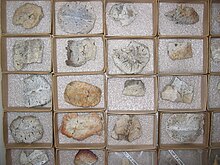Glyptodontopelta
| Glyptodontopelta Temporal range: Late Cretaceous,
| |
|---|---|

| |
| Osteoderms from SMP VP1580 | |
| Scientific classification | |
| Domain: | Eukaryota |
| Kingdom: | Animalia |
| Phylum: | Chordata |
| Clade: | Dinosauria |
| Clade: | †Ornithischia |
| Clade: | †Thyreophora |
| Clade: | †Ankylosauria |
| Clade: | †Euankylosauria |
| Family: | †Nodosauridae |
| Genus: | †Glyptodontopelta Ford, 2000 |
| Type species | |
| †Glyptodontopelta mimus Ford, 2000
| |
| Synonyms | |
| |
Glyptodontopelta (meaning "Glyptodon shield") is a monospecific genus of nodosaurid dinosaur from New Mexico that lived during the Late Cretaceous (lower to upper Maastrichtian, 69 to 66 Ma) in what is now the Naashoibito member of the Ojo Alamo Formation.[1] The type and only species, Glyptodontopelta mimus, is known from numerous specimens that consist of osteoderms, a dentary, supraorbital and bone fragments.[2] It was named in 2000 by Tracy Ford.[1] Edmontonia australis is a junior synonym of Glyptodontopelta.[3]
Discovery and naming
[edit]
Fossils of Glyptodontopelta, consisting only of bony armor, were found in the U.S. state of New Mexico. The type species, Glyptodontopelta mimus, was described by Tracy Lee Ford in 2000.[1] The holotype, USNM 8610, consists of three pieces of fused flat osteoderms, found in the Campanian-Maastrichtian Ojo Alamo Formation. It was concluded to be a dubious name, a nomen dubium, in a 2004 review of the Ankylosauria,[4] but a 2008 publication by Michael Burns concurred with Ford that its armor was distinctive enough to consider it valid. Burns also assigned Glyptodontopelta to Nodosauridae — rejecting Ford's Stegopeltinae — and proposed that another armored taxon from New Mexico, Edmontonia australis, is a synonym of Glyptodontopelta mimus, based on analysis of armor size and shape.[3]
Most specimens referred to Glyptodontopelta comprise isolated osteoderms. The most complete known specimen, SMP VP-1580, comprises the distal part of a left lower jaw (dentary), a left supraorbital, and over a hundred osteoderms and fragments.[2]
See also
[edit]References
[edit]- ^ a b c T.L. Ford. (2000). "A review of ankylosaur osteoderms from New Mexico and a preliminary review of ankylosaur armor", In: S. G. Lucas and A. B. Heckert (eds.), Dinosaurs of New Mexico. New Mexico Museum of Natural History and Science Bulletin 17: 157-176
- ^ a b S.E. Jasinski, R.M. Sullivan, and S.G. Lucas (2011). "Taxonomic Composition of the Alamo Wash Local Fauna from the Upper Cretaceous Ojo Alamo Formation (Naashoibito Member), San Juan Basin, New Mexico", In: R.M. Sullivan et al. (eds.), Fossil Record 3. New Mexico Museum of Natural History and Science 53: 216-271
- ^ a b Burns, Michael E. (2008). "Taxonomic utility of ankylosaur (Dinosauria, Ornithischia) osteoderms: Glyptodontopelta mimus Ford, 2000: a test case". Journal of Vertebrate Paleontology. 28 (4): 1102–1109. Bibcode:2008JVPal..28.1102B. doi:10.1671/0272-4634-28.4.1102. S2CID 140672072.
- ^ Vickaryous, Matthew K.; Maryańska, Teresa; Weishampel, David B. (2004). "Ankylosauria". In Weishampel, David B.; Dodson, Peter; Osmólska, Halszka (eds.). The Dinosauria (Second ed.). Berkeley: University of California Press. pp. 363–392.




